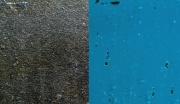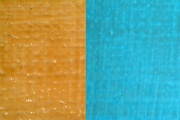Difference between revisions of "Copaiba balsam"
(username removed) |
|||
| (One intermediate revision by one other user not shown) | |||
| Line 1: | Line 1: | ||
| − | [[File:22-35_Coparba.Balsam_glass.jpg|thumb|Copaiba Balsam]] | + | [[File:22-35_Coparba.Balsam_glass.jpg|thumb|Copaiba Balsam on glass<br>visible light left; UV light right]] |
== Description == | == Description == | ||
| − | + | [[File:54-72_Coparba.Balsam_canvas.jpg|thumb|Copaiba Balsam on canvas<br>visible light left; UV light right]] | |
A viscous, oleoresin obtained from South American deciduous trees of the genus ''Copaifera'', native to the Amazon valley and banks of the Orinoco river. The volatile oil and resin contain one or more of the followings acids: illuric, metacopaivic, copaivic, and oxycopaivic. Copaiba balsam was brought to Europe in the 17th century for medicinal use. In the mid-19th century, copaiba balsam (para) with ethanol vapor was used as a varnish cleaner (Pettenkofer method) for oil paintings with blanched and cracked surfaces. However, the no-longer used method produced unwanted long-term effects because the resin penetrated paint and canvas, slightly dissolved linseed oil and left residual resin that darkened with age. In the early 20th century, copaiba balsam was used as a glossy additive in paint media, but later discontinued because of its tendency to darken, interfere with drying and produce cracked paints. Copaiba balsam is currently used to make tracing and photographic papers. | A viscous, oleoresin obtained from South American deciduous trees of the genus ''Copaifera'', native to the Amazon valley and banks of the Orinoco river. The volatile oil and resin contain one or more of the followings acids: illuric, metacopaivic, copaivic, and oxycopaivic. Copaiba balsam was brought to Europe in the 17th century for medicinal use. In the mid-19th century, copaiba balsam (para) with ethanol vapor was used as a varnish cleaner (Pettenkofer method) for oil paintings with blanched and cracked surfaces. However, the no-longer used method produced unwanted long-term effects because the resin penetrated paint and canvas, slightly dissolved linseed oil and left residual resin that darkened with age. In the early 20th century, copaiba balsam was used as a glossy additive in paint media, but later discontinued because of its tendency to darken, interfere with drying and produce cracked paints. Copaiba balsam is currently used to make tracing and photographic papers. | ||
| Line 10: | Line 10: | ||
2) maracaibo balsam (40% copaiba oil) - Venezuela | 2) maracaibo balsam (40% copaiba oil) - Venezuela | ||
| − | |||
== Synonyms and Related Terms == | == Synonyms and Related Terms == | ||
básamo de copaiba (Esp.); balsamo copaibe (It); balsamo copaive (It); para balsam; maracaibo balsam; Jesuits' balsam; balsam capivi; copaiva resin; copaiva balsam; Pettenkofer method | básamo de copaiba (Esp.); balsamo copaibe (It); balsamo copaive (It); para balsam; maracaibo balsam; Jesuits' balsam; balsam capivi; copaiva resin; copaiva balsam; Pettenkofer method | ||
| − | == | + | ==Physical and Chemical Properties== |
| − | |||
| − | |||
| − | |||
| − | |||
| − | + | * Soluble in benzene, chloroform, ether, oils, carbon disulfide, absolute alcohol, ligroin. Insoluble in water. | |
| − | |||
| − | |||
| − | |||
| − | |||
| − | |||
| − | |||
| − | |||
| − | == | + | For para: |
| + | * Saponification number = 80-100 | ||
| + | * Acid number = 75-100. | ||
| + | * Density = 0.930-0.995 g/ml | ||
| + | * Refractive Index = 1.500 -1.506 | ||
| − | + | ==Resources and Citations== | |
| − | + | * S.Schmitt, "The Reprint of Professor Max von Pettenkofer's 1870 publication ''Über Ölfarbe'' in ICOM Preprints, Lyon, France 1999. p.188-193. | |
* R. J. Gettens, G.L. Stout, ''Painting Materials, A Short Encyclopaedia'', Dover Publications, New York, 1966 | * R. J. Gettens, G.L. Stout, ''Painting Materials, A Short Encyclopaedia'', Dover Publications, New York, 1966 | ||
| Line 56: | Line 48: | ||
* ''The Merck Index'', Martha Windholz (ed.), Merck Research Labs, Rahway NJ, 10th edition, 1983 Comment: entry 2580 | * ''The Merck Index'', Martha Windholz (ed.), Merck Research Labs, Rahway NJ, 10th edition, 1983 Comment: entry 2580 | ||
| − | * Art and Architecture Thesaurus Online, | + | * Art and Architecture Thesaurus Online, https://www.getty.edu/research/tools/vocabulary/aat/, J. Paul Getty Trust, Los Angeles, 2000 |
| − | |||
[[Category:Materials database]] | [[Category:Materials database]] | ||
Latest revision as of 13:08, 4 July 2022
Description
A viscous, oleoresin obtained from South American deciduous trees of the genus Copaifera, native to the Amazon valley and banks of the Orinoco river. The volatile oil and resin contain one or more of the followings acids: illuric, metacopaivic, copaivic, and oxycopaivic. Copaiba balsam was brought to Europe in the 17th century for medicinal use. In the mid-19th century, copaiba balsam (para) with ethanol vapor was used as a varnish cleaner (Pettenkofer method) for oil paintings with blanched and cracked surfaces. However, the no-longer used method produced unwanted long-term effects because the resin penetrated paint and canvas, slightly dissolved linseed oil and left residual resin that darkened with age. In the early 20th century, copaiba balsam was used as a glossy additive in paint media, but later discontinued because of its tendency to darken, interfere with drying and produce cracked paints. Copaiba balsam is currently used to make tracing and photographic papers.
Types include:
1) para balsam (60-90% copaiba oil) - Brazil
2) maracaibo balsam (40% copaiba oil) - Venezuela
Synonyms and Related Terms
básamo de copaiba (Esp.); balsamo copaibe (It); balsamo copaive (It); para balsam; maracaibo balsam; Jesuits' balsam; balsam capivi; copaiva resin; copaiva balsam; Pettenkofer method
Physical and Chemical Properties
- Soluble in benzene, chloroform, ether, oils, carbon disulfide, absolute alcohol, ligroin. Insoluble in water.
For para:
- Saponification number = 80-100
- Acid number = 75-100.
- Density = 0.930-0.995 g/ml
- Refractive Index = 1.500 -1.506
Resources and Citations
- S.Schmitt, "The Reprint of Professor Max von Pettenkofer's 1870 publication Über Ölfarbe in ICOM Preprints, Lyon, France 1999. p.188-193.
- R. J. Gettens, G.L. Stout, Painting Materials, A Short Encyclopaedia, Dover Publications, New York, 1966
- R. Mayer, The Artist's Handbook of Materials and Techniques, Viking Press, New York, 1981
- G.S.Brady, Materials Handbook, McGraw-Hill Book Co., New York, 1971 Comment: p. 384
- Reed Kay, The Painter's Guide To Studio Methods and Materials, Prentice-Hall, Inc., Englewood Cliffs, NJ, 1983
- Ralph Mayer, A Dictionary of Art Terms and Techniques, Harper and Row Publishers, New York, 1969 (also 1945 printing)
- Richard S. Lewis, Hawley's Condensed Chemical Dictionary, Van Nostrand Reinhold, New York, 10th ed., 1993
- Hermann Kuhn, Conservation and Restoration of Works of Art and Antiquities, Butterworths, London, 1986
- Kurt Wehlte, The Materials and Techniques of Painting, Van Nostrand Reinhold Co., New York, 1975
- Paintings Specialty Group, Painting Conservation Catalog, Wendy Samet (ed.), AIC, Washington, DC, 1998
- The Merck Index, Martha Windholz (ed.), Merck Research Labs, Rahway NJ, 10th edition, 1983 Comment: entry 2580
- Art and Architecture Thesaurus Online, https://www.getty.edu/research/tools/vocabulary/aat/, J. Paul Getty Trust, Los Angeles, 2000

